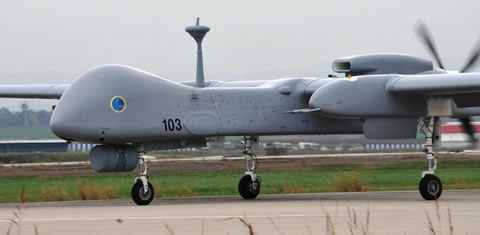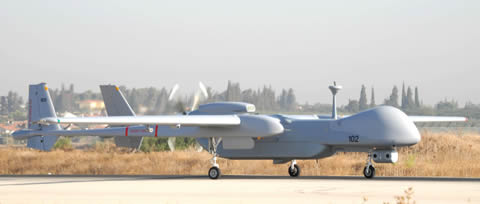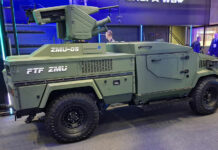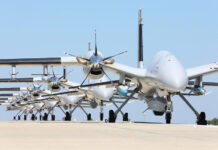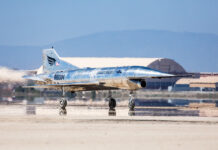
Israel’s Air Force (IAF) has formally accepted today the Eitan (Heron TP) unmanned aircraft – the largest UAV built in Israel, and the second largest operational UAV in the world. 210 Squadron operating from Tel Nof Air Force base was established specifically for this unique new aircraft. While Eitan is a new aircraft, considered to be among the world’s most ophisticated unmanned aircraft, it is answering an operational specification, defined by the IAF over 15 years ago.

“The launching of this airplane is another, substantial landmark in the development of unmanned aerial vehicles. From the humble beginning of their development, with initial operational results during the first Lebanon war, the substantial and professional apparatus now accompanies almost any air force operational frame-work” said Major General Ido Nehushtan, Commander in Chief of the Israel Air Force said during the inauguration ceremony.
The IAF cooperated closely with the industry team in developing the aircraft, headed by IAI as the system development and prime ontractor. The aircraft made its maiden flight in June 2006, three years after the official program ‘kickoff’.

The aircraft adds significantly to the operational capabilities of the IAF, primarily in long endurance, long-range missions, offering new capabilities in carrying heavy payloads, on higher and longer missions than most contemporary UAVs. The IAF never confirmed the combat use of weapon-carrying UAVs, although such missions using U.S. weapons are performed by U.S. forces in Iraq, Afghanistan and Yemen. One of the UAVs built by the Israelis for the U.S. Army – the Hunter, has already been configured to use weapons and is believed to have been operating on combat missions in Iraq and Afghanistan.

Whether the Eitan is capable of carrying weapons has not been officially confirmed though an IAF officer briefing on the new aircraft commented, that “Eitan has the potential to introduce new missions profiles and capabilities, as operators gather more experience with the new aircraft”. Such missions could include aerial refueling of other UAVs, extending the missions of unmanned aircraft to weeks, when necessary. Potential future missions could also include airborne early warning against missile attack, using electro-optical and electro-magnetic sensors. An extension of the missile-defense mission, could also assume the ‘boost phase intercept’ task, attempting to destroy ballistic missiles on their ascent phase, when they are most vulnerable. Israel considered this mission of UAVs equipped with air-to-air missiles known as Missile Optimized Anti-Ballistic Missile System (Moab) back in the 1990s, before embarking on the Arrow missile defense system.
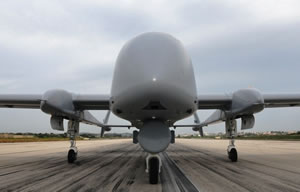
Although Eitan has officially entered service this year, this UAV has already contributed its ISR services during Operation Cast Lead in January 2009. The IAF is currently operating the first batch of aircraft, with more units expected to be delivered after the new system reaches full operational capability.
With maximum takeoff weight of five tons, the turbo-prop powered Eitan can be loaded with multiple payloads and enough fuel for mission endurance exceeding 24 hours, at an altitude over 41,000 ft (above civil aviation flight routes), at ranges exceeding 1,000 km. The top speed at the operational altitude is 200 knots, but the aircraft can also fly slower when required. The length is 15 meters, wing span is 26 meters and height is 3 meters.
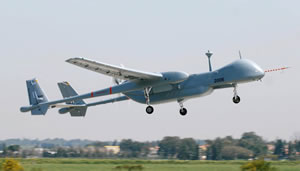
Everywhere you look at this aircraft there is something new that hasn’t been done before” says an IAF officer briefing Defense Update about the aircraft, adding that the Eitan is designed to carry out a wide range of missions, from those similar to other UAVs, to brand new missions that are exclusive for this vehicle, given its unique combination of range, endurance and payload.
“The aircraft is designed around an ‘open architecture’, enabling operators efficiently to introduce new systems and payloads without requiring major changes on the platform.” An IAI official told Defense Update, “the airframe combines several payloads located throughout the aircraft, in the fuselage and under the wings, and in a removable ‘gondola’-shaped fairing, located under the belly and around the center of gravity (CG), enabling rapid reconfiguration of aircraft for specific missions. Eitan can fly without the Gondola, on ‘pure ISR’ missions, or perform multifarious missions with multiple payloads, as the mission requires. A distinctive payload is the high power electro-optical system, mounted ahead of the nose landing gear, offering unobstructed hemispherical view for the telescopic thermal camera. This highly stabilized payload, unique to the IAF, offers unprecedented long-range and high altitude performance, sofar provided only by fixed wing aircraft.”
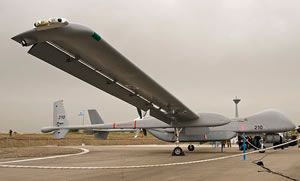
Unlike multi-mission jet fighters, designed to perform in a wide operational envelope, Eitan was designed to excel in a specific domain – relatively low speed, medium to high altitude, and long endurance. The aerodynamic design selected for the aircraft has matched these attributes – twin tail with large horizontal stabilizer, the large, unswept wing’s airfoil and profile, are optimized for cruising at high altitude. The wide fuselage, contributing to body lift, is further adding to extending endurance in cruising speed.
According to IAF personnel, the large payload capacity of Eitan enabled the IAF to equip the aircraft with sophisticated defensive systems, similar to modern combat aircraft. Some of the systems are visible in different locations around the aircraft. The aircraft has built-in features supporting safe operation in controlled airspace, including several video cameras, on the wing and tail, providing wide field of view for ‘see and avoid’ flight. Other sensors like the Interrogator Friend and Foe (IFF) already introduced in the basic platform, provide part of the functionality required for ‘sense and avoid’ capability. Both sensors are considered mandatory for future flight certification in civil-controlled airspace, currently being formulated by civil aviation authorities in the U.S., Europe and Israel. Furthermore, the payload reserves available in the aircraft also provide for installation of TCAS systems, if required.
Two different Heron TP ‘Eitan’ UAVs demonstrating the two configurations – with and without the missionspecific Gondola. Photos: IAI and IAF.

